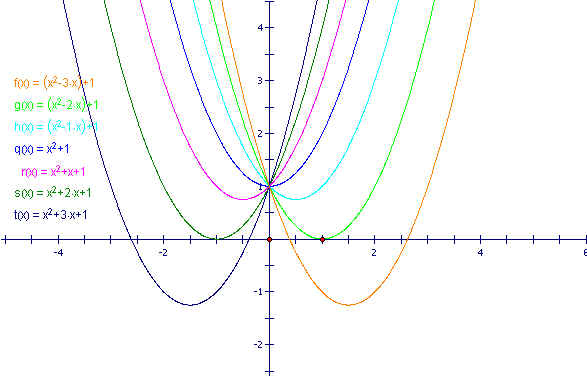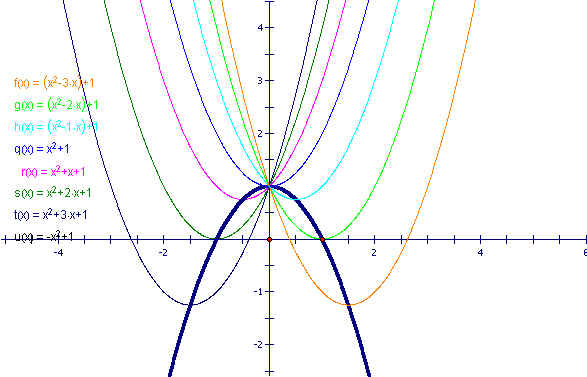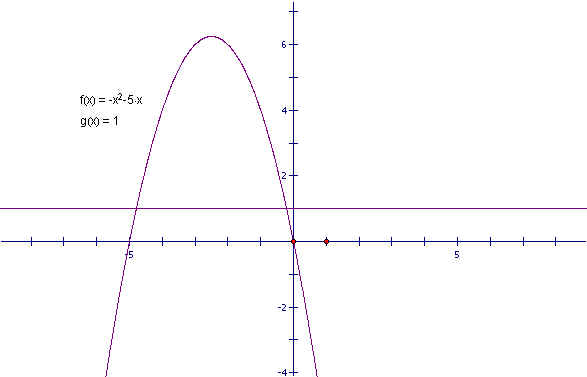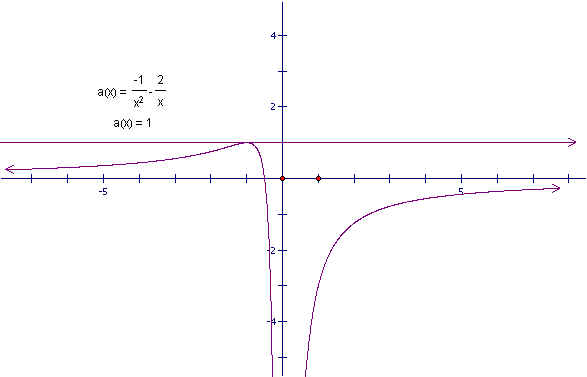
ax2 + bx + c = 0
It has now become a rather standard exercise, with available technology, to construct graphs to consider the equation
ax2 + bx + c = 0
and to overlay several graphs of
y = ax2 + bx + c
for different values of a, b, or c as the other two are held constant. From these graphs discussion of the patterns for the roots of
ax2 + bx + c = 0
can be followed. For example, if we set a=1, we obtain the equation
y = x2 + bx + 1
By setting b = -3, -2, -1, 0, 1, 2, 3, and overlay the graphs, the following picture is obtained.

We can discuss the
"movement" of a parabola as b is changed. The parabola
always passes through the same point on the y-axis ( the point
(0,1) with this equation). For b < -2 the parabola will
intersect the x-axis in two points with positive x values (i.e.
the original equation will have two real roots, both positive).
For b = -2, the parabola is tangent to the x-axis and so the
original equation has one real and positive root at the point of
tangency. For -2 < b < 2, the parabola does not intersect
the x-axis -- the original equation has no real roots. Similarly
for b = 2 the parabola is tangent to the x-axis (one real
negative root) and for b > 2, the parabola intersects the
x-axis twice to show two negative real roots for each b.
If we examine the locus of the vertices of the set of parabolas
graphed from
y = x2 + bx + 1
We can see that the locus is the blue parabola
y = -x2 + 1

From this graph we can conclude for the equation x2
+ bx + c, the parabola formed by the movement of the locus as b
is varied, will always intersect the y-axis at c. Therefore the
equation for this parabola will be -ax2 + c.
Consider again the equation
x2 + bx + 1 = 0
Now graph this relation in the xb
plane. We get the following graph.

If we take any particular value of
b, say b = 5, and overlay this equation on the graph we add a
line parallel to the x-axis. If it intersects the curve in the xb
plane the intersection points correspond to the roots of the
original equation for that value of b. We have the following
graph.

For each value of b we select, we
get a horizontal line. It is clear on a single graph that we get
two negative real roots of the original equation when b > 2,
one negative real root when b = 2, no real roots for -2 < b
< 2, One positive real root when b = -2, and two positive real
roots when b < -2.
Consider the case when c = - 1, in red, rather than c= + 1, in
green. Below is the graph of both with b = 5.

We can see from this graph that when b=-1, we will always get two real roots. One root will be positive and the other will be negative for all values of b. As one root becomes larger the other will approach zero.
In the following example the equation
x2 + 5x + c = 0
is considered. If the equation is graphed in the xc plane, it is easy to see that the curve will be a parabola. For each value of c considered, its graph will be a line crossing the parabola in 0, 1, or 2 points -- the intersections being at the roots of the original equation at that value of c. In the graph, the graph of c = 1 is shown. The equation x2 + 5x + 1 = 0 will have two negative roots -- approximately -0.2 and -4.8. We can see this in the graph below.

There is one value of c where the
equation will have only 1 real root -- at c = 6.25. For c >
6.25 the equation will have no real roots and for 0< c <
6.25 the equation will have two roots, both negative. The
equation will have one negative and one 0 root when c = 0 and one
negative and one positive when c < 0.
Now consider the xa plane and the equation
ax2 + 2x + 1 = 0
When we graph this relation we get the graph below. Click here to see this sketch in GSP.

For this equation when a = 0 there is only one real root at negative 0.5. There are two negative roots when 1 > a > 0 and no real roots when a>1. There are two real roots, one positive and one negative, when a < 0. As a gets smaller the two real roots get closer and closer to zero.